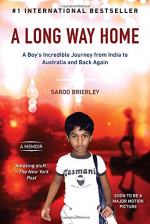|
This section contains 726 words (approx. 2 pages at 400 words per page) |

|
A Long Way Home Summary & Study Guide Description
A Long Way Home Summary & Study Guide includes comprehensive information and analysis to help you understand the book. This study guide contains the following sections:
This detailed literature summary also contains Topics for Discussion on A Long Way Home by Saroo Brierley.
Note: This study guide specifically refers to the June 2015 Berkley Books/Random House trade paperback edition of A Long Way Home by Saroo Brierly.
A Long Way Home: A Boy’s Incredible Journey from India to Australia and Back Again is a memoir by Saroo Brierly which recounts his childhood journey of being lost in India and adopted, and his adulthood journey of returning to India to retrace his steps and find his family. As a young boy of about five or six, Saroo loved his family, including his mother, Kamla, his brothers, Guddu and Kallu, and his sister, Shekila. The family, abandoned by Kamla’s husband for another family, barely scraped by. While Kamla earned the equivalent of a $1.30 each day, Saroo and his brothers hit the streets to scrounge and beg for food. Guddu and Kallu even began going up and down the rail line to beg and scrounge, or to find work where they can.
One night, Saroo went with Guddu to the train station in the next town, where incredibly tired, he decided to sleep on a station platform bench. Guddu told him not to leave, for he would be back after taking care of some things. When Saroo woke up, Guddu was gone, so he decided to sleep on a more comfortable train car bench. When Saroo woke up the second time, the train was full of people and was traveling. Saroo was panicked. The train ultimately brought him to Calcutta, where he spent days attempting to ride the right train home, but was never able to do so. He was ultimately taken to the police by a kind teenage boy. The police fed and sheltered Saroo, and sent him to a detention center to be cared for until his family could be reached. When this failed, Saroo was taken in by ISSA, the Indian Society for Sponsorship and Adoption. Not long after, Saroo was adopted by an Australian couple named John and Sue Brierly, whom he would come to call Mum and Dad.
Mum and Dad did all they could to make Saroo’s transition to Western society easier, from decorating the house with Indian prints, materials, and décor to putting a large map of India on Saroo’s bedroom wall. Saroo was amazed at how much better life was in Australia, and how easy assimilation was thanks to his parents. Some years later, Mum and Dad adopted a second Indian boy named Mantosh. Saroo and Mantosh both deeply loved Mum and Dad, but Saroo always wondered about the fate of his Indian family. As Saroo grew, he became thoroughly Western in mannerisms and language, and went on to college and hotelier school. During this time, he began in earnest efforts to find his hometown and Indian family, made easier by Google Earth. After years of searching, and an eight-month period of obsessive searching in 2010, Saroo finally found his hometown based on local landmarks and geographic features.
With the encouragement of his adoptive parents, Saroo traveled back to India to the town of Khandwa, where he reunited with his mother, his brother Kallu, and sister Sheikila. He met their families. Saroo’s Indian family was thrilled to see him again, and they were grateful for Saroo’s Australian family having cared for him for so long. Sadly, Saroo learned that Guddu never came back for him at the station all those years before was because Guddu had been killed by a train. During his second visit to India, Saroo decided to follow his route as a child to Calcutta by taking the train. The experience brought up many sad memories, but also allowed Saroo to thank some of the people who helped him along the way, such as one of the workers at ISSA who oversaw his adoption procedure. Having made peace with the past, Saroo looked to the future. In an epilogue, the reader learns that currently, Saroo is arranging for a new house for his Indian mother, and journeys with his Australian mother to India to meet his Indian mother for a feature on a television program (60 Minutes) in Australia. Though Saroo possesses no religious belief, he does believe in fate. He believes that everything that has happened to him has happened as it should for him to be where he is in the present.
Read more from the Study Guide
|
This section contains 726 words (approx. 2 pages at 400 words per page) |

|



